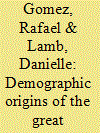| Srl | Item |
| 1 |
ID:
119160


|
|
|
|
|
| Publication |
2013.
|
| Summary/Abstract |
The demographic dividend, that is, the growth of the working age population aged 16 years relative to younger and older age dependents, has often been cited as a crucial component of the accelerated economic growth experienced by disparate countries and regions at different points in time. Generally less emphasized are the ramifications of this process when it occurs in reverse; that is, when the relative size of the working age population begins to shrink. Related to this is the more subtle effect of changes to the age structure of the overall working age population, which can have compounding or offsetting effects in relation to the demographic dividend noted above. This paper explores how these age-related phenomena were instrumental to both the Great Depression and the Great Recession of 2008. We explore how the generational composition of economic actors and the aging of the baby-boom worker may have played a role in provoking these remarkable recessionary periods. The reversal of the demographic dividend and the aging of the working age population are factors now contributing to the propagation of the global economic downturn, as witnessed in the example of Japan over the past half-century. This paper applies the lessons of the Great Depression to offer a forward-looking analysis of the Chinese economy. China is on the precipice of a significant demographic shift whose implications for economic growth are explored.
|
|
|
|
|
|
|
|
|
|
|
|
|
|
|
|
| 2 |
ID:
177693


|
|
|
|
|
| Summary/Abstract |
This study aims to document the age structure and mortality by age in the Ottoman city of Bursa that served as a politically and commercially significant urban center over centuries. It uses a set of hitherto unexamined Ottoman population registers kept in 1839 and updated until 1842 that provide detailed self-reported data on all male inhabitants regardless of age, including deaths, births, and migration. The study tests the quality of age and mortality data in conjunction with the Coale and Demeny regional model life tables and compares the results to historical demographic studies conducted for European regions. The results point to a demographic structure marked by high birth and death rates and prove promising for extending back the study of Ottoman demographic transition and establishing historical comparison points with the global experience.
|
|
|
|
|
|
|
|
|
|
|
|
|
|
|
|
| 3 |
ID:
139651


|
|
|
|
|
| Summary/Abstract |
This artice analyse demographic factors particularly the population age structure in the political equation of nation-states. Examples are provided in contexts as diverse as the Congo, Palestine and Venezuela. The statistics are particularly revealing if the relative cohort size comparison method is used.
|
|
|
|
|
|
|
|
|
|
|
|
|
|
|
|